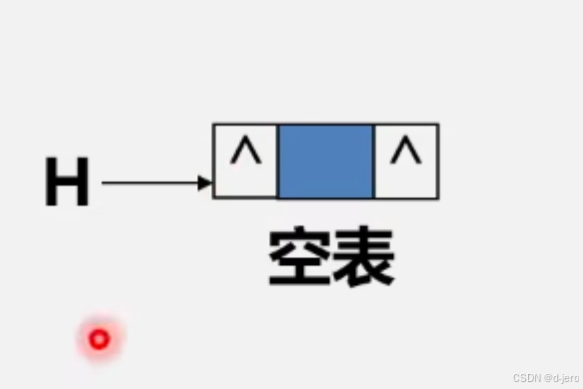一、循环链表
循环链表就是首尾相接的的链表,就是尾节点的指针域指向头节点使整个链表形成一个循环,这就弥补了以前单链表无法在后面某个节点找到前面的节点,可以从任意一个节点找到目标节点,但是现在我们就不能像以前那样停止循环时的判断条件是否为NULL了,而是判断是否指向头指针


由于我们的操作经常是在链表的首位进行操作,所以我们引进尾指针的概念,这样以后就可以直接找到操作尾节点

下面是循环单链表的相关代码:
typedef struct
{int data;Lnode* next;
}*CirList,Lnode;//初始化一个循环单链表
bool init_list(CirList& l)
{l = new Lnode;//开辟空间作为头节点if (l == NULL)return false;l->next = l;//头指针的指针域指向自己return true;
}//判断循环单链表是否为空表
bool isEmpty(CirList& l)
{if (l->next == l)return true;return false;
}
二、双向链表
由于单链表无法逆向检索,循环链表逆向寻找元素时间复杂度也是O(n),所以这里提出双向链表的概念,就是给每个元素一个前驱指针,这样我们就可以直接逆向检索上一个元素了,而且时间复杂度为O(1);双向链表的空表里面两个指针装的都是空指针

#include<iostream>
using namespace std;
typedef struct Lnode
{int data;Lnode* next,*prior;
}*DoubList,Lnode;//初始化一个双向链表
bool init_list(DoubList& l)
{l = new Lnode;if (l == NULL)return false;l->next = NULL;l->prior = NULL;return true;
}//双向链表建立(前插法)
bool insert_list(DoubList& l)
{init_list(l);int x;while (cin >> x && x != 0){Lnode* p = new Lnode{x,l->next,l};if (p == NULL)return false;if (l->next)l->next->prior = p;l->next = p;}return true;
}//双链表建立(后插法)
bool insert_tail_list(DoubList& l)
{init_list(l);int x;Lnode* r =l;while (cin >> x && x != 0){Lnode* p = new Lnode{ x,NULL,r };if (p == NULL)return false;r->next = p;r = p;}return true;
}//按位插入:在i位插入元素e
bool insertElem(DoubList& l, int i, int e)
{if (i < 1)return false;int j=0;Lnode* r = l;while (j < i - 1 && r->next != NULL){r = r->next;j++;}if (j != i - 1)return false;Lnode* p = new Lnode{ e,r->next,r };if (r->next)r->next->prior = p;r->next = p;return true;
}//按值删除元素e
void deleteElem(DoubList&l,int e)
{if (!l->next)cout << "删除失败:链表为空" << endl;Lnode* r = l->next;while (r){if (r->data == e){r->prior->next = r->next;if (r->next)r->next->prior = r->prior;delete r;r = NULL;return;}r = r->next;}
}//打印双链表
void print(DoubList l)
{Lnode* p=l;while (p->next){p = p->next;cout << p->data << "\t";}cout << endl;
}int main()
{DoubList l;insert_list(l);print(l);deleteElem(l, 3);print(l);return 0;
}
三、循环双向链表
即使我们有了双向链表,但是当我们想要在尾节点找到头节点附近某个节点仍然不够快捷,所以就引进了循环双向链表的概念,不过判断条件这些就需要改变:判断结束条件从NULL变为链表名L
#include<iostream>
using namespace std;
typedef struct Lnode
{int data;Lnode* next,*prior;
}*DoubCirList,Lnode;//初始化一个循环双向链表
bool init_list(DoubCirList& l)
{l = new Lnode;if (l == NULL)return false;//指针域都指向自身l->next = l;l->prior = l;return true;
}//双向循环链表建立(前插法)
bool insert_list(DoubCirList& l)
{init_list(l);int x;while (cin >> x && x != 0){Lnode* p = new Lnode{x,l->next,l};if (p == NULL)return false;l->next->prior = p;l->next = p;}return true;
}//双链表建立(后插法)
bool insert_tail_list(DoubCirList& l)
{init_list(l);int x;Lnode* r =l;while (cin >> x && x != 0){Lnode* p = new Lnode{ x,l,r };if (p == NULL)return false;r->next = p;r = p;}return true;
}//按位插入:在i位插入元素e
bool insertElem(DoubCirList& l, int i, int e)
{if (i < 1)return false;int j=0;Lnode* r = l;while (j < i - 1 && r->next != l){r = r->next;j++;}if (j != i - 1)return false;Lnode* p = new Lnode{ e,r->next,r };r->next->prior = p;r->next = p;return true;
}//按值删除元素e
void deleteElem(DoubCirList&l,int e)
{if (l->next==l)cout << "删除失败:链表为空" << endl;Lnode* r = l->next;while (r!=l){if (r->data == e){r->next->prior = r->prior;r->prior->next = r->next;delete r;r = NULL;return;}r = r->next;}
}//打印双链表
void print(DoubCirList l)
{Lnode* p=l;while (p->next!=l){p = p->next;cout << p->data << "\t";}cout << endl;
}int main()
{DoubCirList l;insert_tail_list(l);print(l);return 0;
}



![滚雪球学MySQL[3.2讲]:MySQL聚合函数与分组详解:COUNT、SUM、AVG、MAX、MIN及GROUP BY与HAVING](/images/no-images.jpg)
![[每周一更]-(第117期):硬盘分区表类型:MBR和GPT区别](https://i-blog.csdnimg.cn/direct/a169d56a0bd44c1e9a4c90be81f7fc2e.jpeg#pic_center)